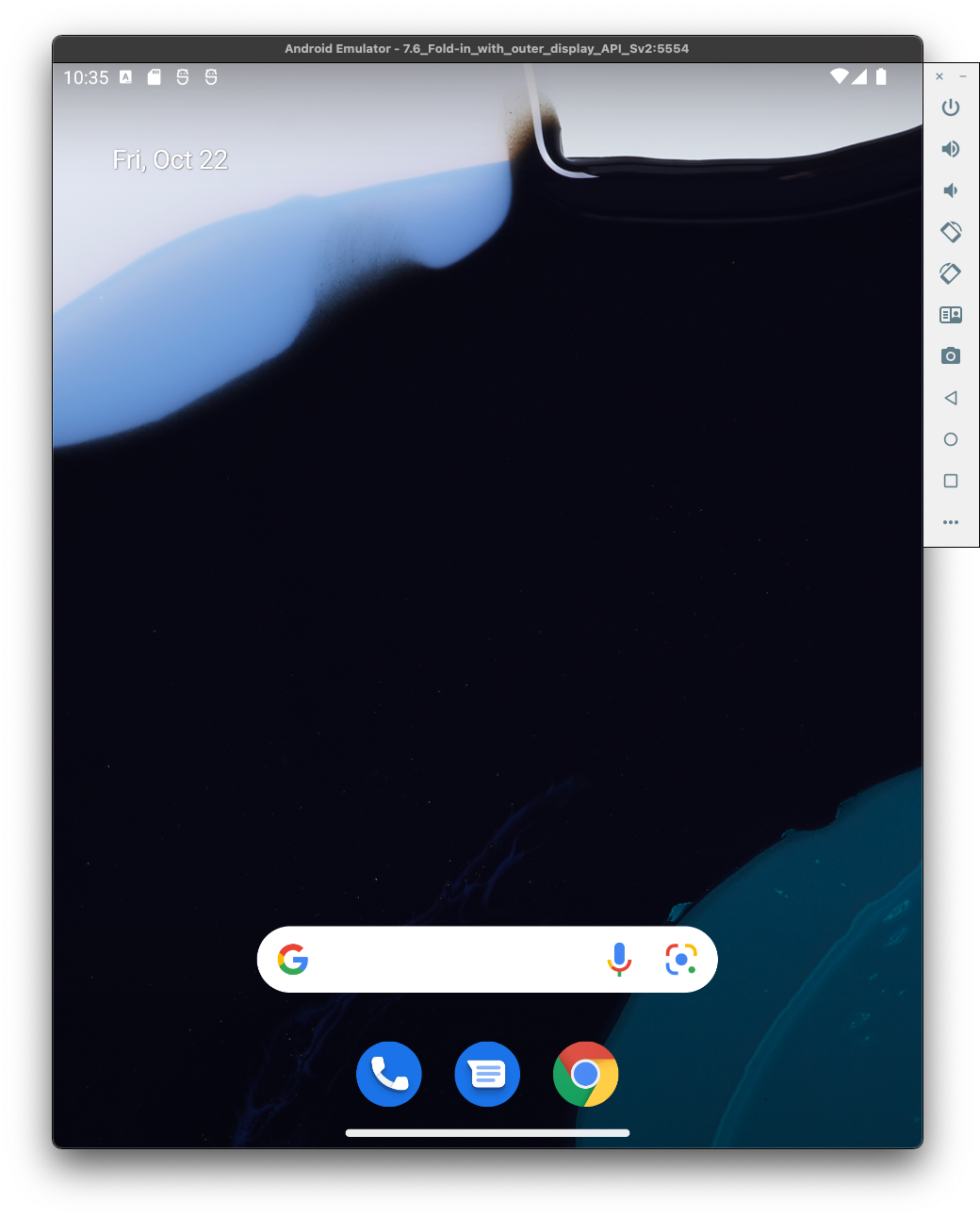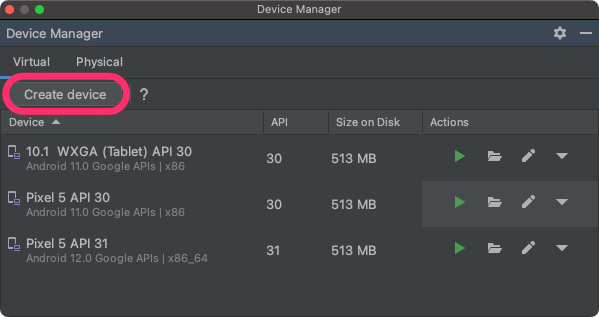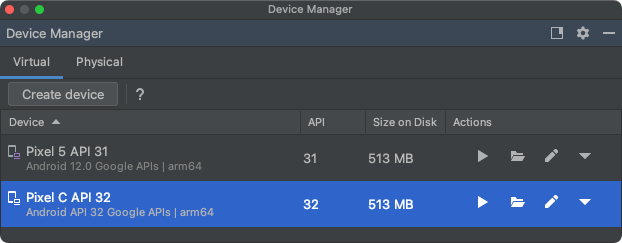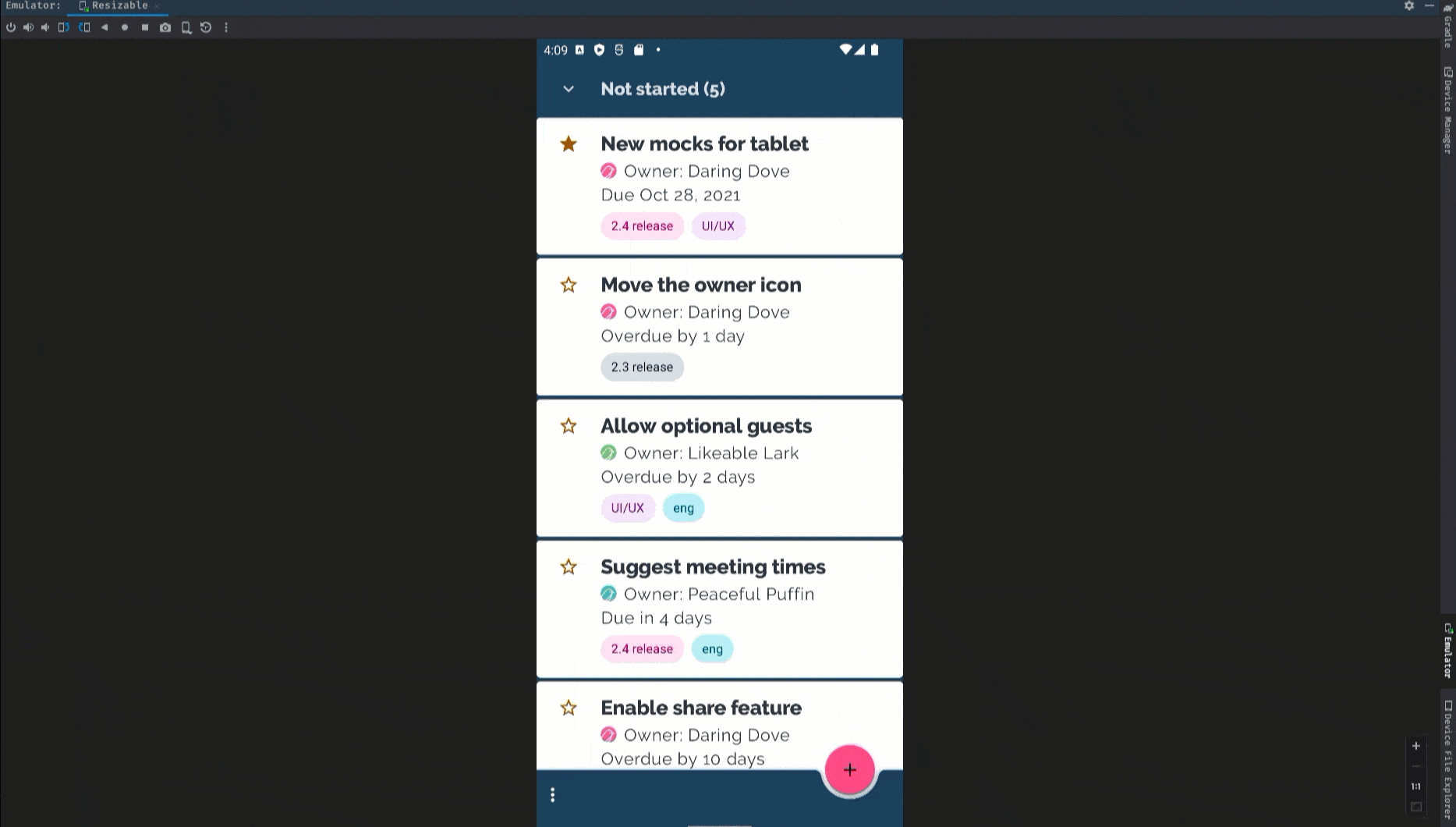
您可以通过以下任一方式获取 Android 12L 功能更新:
- 通过 Android Studio 下载 Android 12L 模拟器映像
- 在合作伙伴设备上获取 Android 12L
- 在 Google Pixel 设备上获取 Android 12L
- 获取通用系统映像 (GSI)
下方提供了完整说明。您可以快速进行设置,在各种尺寸的屏幕上试用您的应用。
如需了解要测试的内容,请参阅让您的应用做好准备。
设置 Android 12L 虚拟设备
如需设置 Android 12L 虚拟设备,请按以下步骤操作:
在 Android Studio 中,依次点击 Tools > SDK Manager。
在 SDK Tools 标签页中,选择最新版 Android 模拟器,然后点击 OK。如果尚未安装最新版本,则此操作会安装最新版本。
在 Android Studio 中,依次点击 Tools > Device Manager,然后在 Device Manager 面板中点击 Create device。

选择大屏设备的设备定义,例如 Tablet 类别中的 Pixel C 或 Phone 类别中的 7.6" Fold-in with outer display,然后点击 Next。
找到 Android 12L 系统映像(名为 Android API 32),然后点击 Download 获取该映像。下载完成后,选择该系统映像,然后点击 Next。

完成虚拟设备的其他设置,然后点击 Finish。

返回设备管理器中的虚拟设备列表,找到您的 12L 虚拟设备,点击 Launch
 以启动它。
以启动它。
重复上述步骤,创建多种大屏设备定义,以用于在各种大屏设备场景中测试您的应用。
可调整大小的模拟器
除了为 Android 12L 配置的大屏虚拟设备外,您还可以试用 Android Studio Chipmunk | 2021.2.1 或更高版本中新增的可调整大小设备配置。将可调整大小设备定义与 Android 12L 系统映像结合使用时,Android 模拟器可让您在四种参照设备(手机、可折叠设备、平板电脑和桌面设备)之间快速切换。使用可折叠参照设备时,您还可以在折叠和展开状态之间切换。
借助这种灵活性,您可以更轻松地使用相同的参照设备,在设计时验证布局以及在运行时测试行为。如需创建新的可调整大小的模拟器,请使用 Android Studio 中的设备管理器创建新的虚拟设备,然后选择 Resizable 设备定义。

在合作伙伴设备上获取 Android 12L
我们与联想合作为您提供 Android 12L,供您在联想 P12 Pro 上试用该版本。
您可以访问联想的 Android 12L 预览网站,了解如何在联想 P12 Pro 上安装 Android 12L。
联想会按照自己的时间表提供 Android 12L 更新,并会提供自己的问题报告渠道,以便您报告在其设备上发现的问题。我们强烈建议您使用联想的反馈渠道报告特定于其设备的 bug 和反馈。
在 Google Pixel 设备上获取 Android 12L
如果您使用的是受支持的 Google Pixel 设备,可以查看并更新 Android 版本,通过无线下载的方式获取 Android 12L。
在大多数情况下,改用 Android 12L 不需要重置所有数据,但建议您在设备上安装 Android 12L 前对数据进行备份。
Android 12L OTA 和下载内容适用于以下 Google Pixel 设备:
- Pixel 3a 和 Pixel 3a XL
- Pixel 4 和 Pixel 4 XL
- Pixel 4a 和 Pixel 4a (5G)
- Pixel 5 和 Pixel 5a
- Pixel 6 和 Pixel 6 Pro
刷写或手动安装系统映像
另外,如果您希望刷写设备,建议您使用 Android 刷写工具。
如果出于其他原因需要手动刷写设备,您可以在 Pixel 下载页面上获取适用于您的设备的 Android 12L 系统映像。请阅读有关如何将系统映像刷写到设备上的一般说明。当您需要更好地控制测试(例如自动测试或回归测试)时,此方法会很有用。
获取通用系统映像 (GSI)
Android 通用系统映像 (GSI) 二进制文件可供开发者在受支持且符合 Treble 标准的设备上进行应用测试和验证。在 Android 12L 正式发布之前,您可以使用这些映像解决 Android 12L 的所有兼容性问题,并发现和报告操作系统和框架方面的问题。
如需了解设备要求、刷机说明以及有关为设备选择正确映像类型的信息,请参阅 GSI 文档。准备好下载 GSI 二进制文件后,请参阅 GSI 版本页面上的 Android 12 GSI 部分。
后续步骤
为 Android 12L 配置设备后,接下来您需要执行以下操作:

